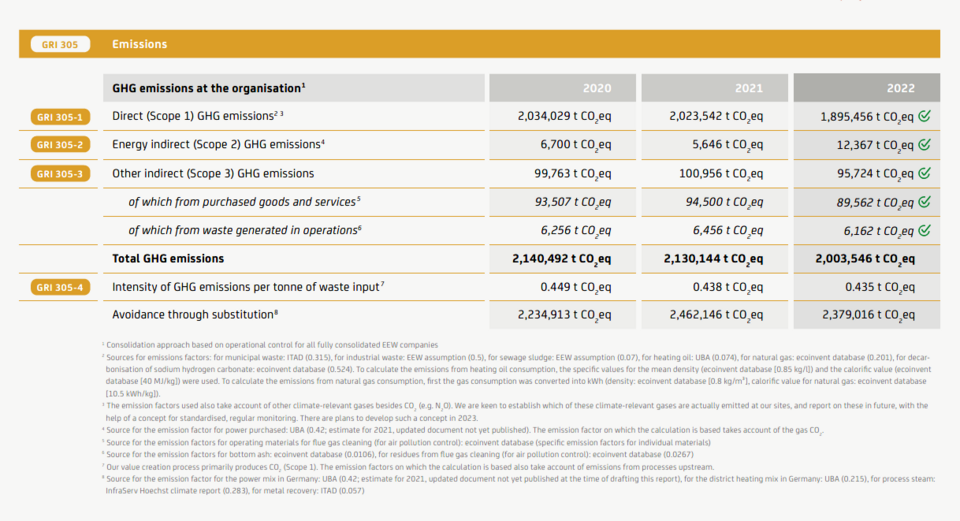We’re improving the CO₂ balance. A plus for the environment.
The generation of energy from waste is active environmental protection. In a number of ways. With an average proportion of 50 percent biogenic materials in the waste, it is recognised that the energy produced in waste incineration plants is energy from renewable sources in accordance with the German Renewable Energies Act (EEG) and thus contributes to achievement of climate goals in Germany and Europe. Using waste for energy production enables us to avoid using primary energy sources like coal, gas and oil. At the same time using the fuels from the EEW plants for energy improves the CO2 balance. This positive climate balance shows that besides recycling suitable materials, the treatment of waste to produce energy also represents an important element of the ecological recycling economy.
Intelligent resource management.
Waste recycling has priority over disposal. The hi-tech EEW plants and constant innovations guarantee the safe and also environmentally sustainable treatment of waste from households, trade and industry. In the incineration process the harmful substances contained within the waste are either destroyed or removed from the materials cycle. Raw materials filtered out and residual materials like slag for road construction are returned to the materials cycle to be reused. In the recycling process the overall volume of the waste is reduced by approx. 90 percent and at the same time new energy is produced – an intelligent and particularly environmentally efficient form of resource management.
Emissions below statutory limits.
Also exemplary: emissions from the EEW plants are substantially below the strict statutory limits. Generally the air released from our plants is significantly less contaminated than city air. Waste which cannot be avoided or recycled is given an important final task with EEW Energy from Waste: we give waste a job in climate protection.
Our ecological key figures at a glance.
We record and report the direct and indirect greenhouse gas (GHG) emissions from our business activity in accordance with the requirements set out in the GRI Standards and in line with the Greenhouse Gas Protocol standard. You can find more information on this in our current sustainability report in chapter "Climate-relevant emissions (output)".
Our sustainability roadmap sets out 14 goals in 5 fields of action that we want to achieve as the EEW Group by 2030. In addition, we have identified specific measures for our site in Delfzijl, the Netherlands, with the help of a CO2 performance ladder and its certification by the Foundation for Climate-Friendly Procurement and Enterprises (SKAO) in order to further reduce our carbon footprint.
Waste incineration plants as pollutant sinks.
Thanks to the latest filtering and firing technology, waste incineration plants fulfil higher environmental standards than other industrial plants. The amendment of the 17th Directive of Germany's Federal Immission Control Act (17th BImSchV) resulted in the definition of the most stringent emission limit values worldwide as well as strict emission monitoring requirements.
This has made waste incineration plants the most stringently regulated industrial plants in Germany. These Europe-wide standards are exemplary.
Less Emissions from Waste Incineration.
Emissions attributable to waste incineration have decreased continuously since 1990. The output of dioxin from all of the 66 waste incineration plants in Germany reported for 2005 has for instance decreased to a thousandth of the original value: less than 0.5 g compared to 400 g in the early 90s. This is all the more impressive in view of the fact that the waste incineration capacity has doubled since 1985. The following comparison is worth noting: the dioxin emission from fireplaces and tiled stoves in private households is about 20 times that amount. Dioxins are however only produced in flue gas; only a small proportion is found in waste itself.
Flue gas contamination with toxic heavy metals such as lead and mercury or poisons such as arsenic on the other hand occurs through the waste. The same applies for dust. Upstream positioning of highly effective flue gas cleaning systems prevents these substances from leaving the waste incineration plant via the chimney.
Refuse burning plants also operate as pollutant sinks, since they remove pollutants contained in waste from the environment permanently.
CO2-Neutral Energy Generation is Climate Protection.
In the past, biological and chemical processes involving the biogenic proportion of residual waste on refuse dumps gave rise to climate-damaging emissions such as carbon dioxide and methane. These emissions contributed significantly to development of the greenhouse effect.
A total of 1.5 million metric tons of methane were emitted from German landfills in 1990. Methane is 21 times more climate-damaging than carbon dioxide. Emissions were reduced to 0.5 million metric tons by 2004 thanks to a combination of factors, including reduction of waste dump capacities, utilisation of the emitted landfill gas and increased waste recycling in incineration plants.
Saving Primary Energy.
Waste treatment using highly efficient thermal processes helps to save on primary energy sources (coal, gas, petroleum), which in turn leads to less climate-relevant emissions. The amount of fossil energy carriers saved every year by making use of the energy contained in waste is equivalent to the energy normally consumed by 700,000 German citizens.
A proportion of the waste is moreover a source of renewable energy (wood, cardboard, paper). In the process of growing, plants and trees take up CO2 from the air, thereby removing it from the environment as it were. When such material is incinerated, the stored CO2 is released again, but does not give rise to any additional CO2 emission: it is climate-neutral.
Since 1990, climate-damaging emissions from waste management have dropped by 30 million metric tons of carbon dioxide. This corresponds to the emissions by 2.5 million German citizens. This is why treating waste in highly modern thermal treatment plants with efficient utilisation of energy is a significant contribution to protecting the climate.
We incinerate for industry.And substitute primary fuels.
The abandonment of fossil fuels such as coal, oil and gas is a central component of sustainable environmental policy. Particularly in energy-intensive industrial processes environmentally friendly and economically viable alternatives to traditional primary fuels are needed. Unlike finite resources, waste represents a more or less inexhaustible supply with interesting energy potential and that’s why it is the specialist subject of EEW Energy from Waste (EEW). Alongside modern waste incineration plants, EEW develops, builds and runs power plants which operate on specially processed household, trade and industrial waste. These substitute fuels have a considerably higher energy value than ordinary household waste and serve large-scale industry in particular for the decentralised production of energy in the form of electricity, heating and process steam.
Scrupulous environmental stipulations
The burning of substitute fuels is subject to strict environmental conditions. Defined minimum temperatures of 850°C in the boiler ensure that any pollutants within the waste, such as dioxins and furans, are completely destroyed. Nitrogen oxides are converted by the addition of uric acid into environmentally neutral nitrogen and water. Multi-stage flue gas purification reduces dust, heavy metals and other pollutants to a minimum. The remaining slag is processed and re-used in road and landfill site construction, flue ash and filter dust is disposed of sustainably. This ensures that the secondary fuels provide energy without causing ecological harm.
Reduction of CO2 emissions
In the seven current refuse-driven fuel (RDF) plants which EEW operates independently or in conjunction with industry partners, a total of 1.4 to 1.5 tonnes per annum of secondary fuels are incinerated. By substituting fossil fuels the RDF plants of the corporate group are making a significant contribution to reducing environmentally-damaging CO2 emissions. Depending on the biogenetic make-up of the substitute fuels, up to a third less carbon dioxide is released in comparison to coal. Secondary fuels are therefore increasingly becoming the first choice.
Overview
End of the Line for Pollutants.
The combustion of waste results in the production of a mixture of gases containing pollutants such as carbon dioxide, sulphur dioxide, dust and soot, as well as nitrogen oxides, heavy metal bearing fumes and unburned hydrocarbons.
The pollutants can be removed from the flue gases by using the latest flue gas cleaning systems, so that harmful organic and inorganic substances are no longer discharged into the atmosphere. These substances are partly incorporated in the reaction-neutral slag or concentrated in the filter dust as end product of the flue gas cleaning process, allowing them to be deposited safely underground.
Pollutants are therefore continuously removed from the environmental cycle - pollutants that were formerly emitted to the environment from waste dumps.
Components
System Chains Provide Flexibility and Safety.
Modern flue gas cleaning systems guarantee a targeted degradation of pollutants by means of different system chains. Which system chain is used again depends on the particular conditions of the site location and the composition of the waste.
None of these system components purifies one exclusive flue gas component. It can for instance contribute to separation of solids as well as to cleaning from organic trace impurities and heavy metals.
Various manufacturer-specific flue gas cleaning methods exist at present, which are composed of variable system components. Irrespective of the procedure, solids, contaminated gases and organic trace impurities are separated, and heavy metal components are removed by filtration.
The waste incineration process produces dioxins and furans (from combustion) as well as gaseous forms of heavy metals such as mercury and cadmium. These substances are already contained in the waste and are liberated by the combustion process.
In old landfill sites, these pollutants were allowed to enter the environmental cycle untreated. Even the redevelopment of old and the construction of new waste dumps did not prevent the continued existence of these pollutants in spite of environmental barriers.
Flue gas cleaning however removes these pollutants from the environment permanently.
Solids seperation
An important part of flue gas purification is the removal of particulates from the exhaust gas. These dusts are partly produced during the incineration process, but also by the individual components of the flue gas cleaning process - such as the spray absorber, by spraying activated carbon and lime milk.
Different methods are available for this, such as filtration of particles through porous materials or separation by means of centrifugal force. Another option is to charge the dust particles electrostatically, which can also be combined with wet cleaning.
A number of system components can be made use of for the solids separation process. To a certain degree, they are also effective when used for the separation of gaseous pollutants.
Denitrogenation
Modern waste incineration facilities make use of various combustion technology systems. A well controllable incineration efficiency chiefly depends on a coordination of grate system, furnace chamber, reburning zone and steam generator type.
A high degree of decomposition of all hydrocarbon compounds is achieved if good flue gas turbulence is achieved by the incineration air and gas feed-through.
This is not the case for nitrogen oxide compounds (NOx), i.e. the gaseous oxides of nitrogen. These are produced in the course of every combustion process. In combination with solar irradiation, harmful ozone can be formed when these compounds enter the environment. Nitrogen oxides are also responsible for the development of smog and acid rain.
Two steps prevent the discharge of harmful nitrogen oxide compounds to the atmosphere during waste incineration. The first step involves incineration temperature optimisation: this reduces NOx production by up to 30 percent.
The second step involves two processes which achieve a reduction of up to 90 percent. EEW Energy from Waste plants use the SNCR process for this.
Organic Trace Substances
Dioxins and Furans
Dioxins and furans include over 200 compounds that can basically be described as chlorine-containing hydrocarbons of varying toxicity. They do not occur in nature, but are unwanted side products of all kinds of combustion processes.
The emission of dioxin has been reduced continuously over the past ten years. Reasons for this achievement include the optimisation of operating conditions, the development of more effective flue gas cleaning methods in conjunction with higher incineration temperatures. Dioxins and furans are destroyed at temperatures above 900°C. Complete burn-up of flue gases is therefore a considerable contribution to minimisation of dioxin/furan emissions.
Emissions can also be reduced significantly by favourable management of the flue gases. This means getting the flue gases beyond the critical temperature of 900°C as quickly as possible without the gases cooling off in the process, because cooling off could be associated with new formation of pollutants.
A residence time of at least two seconds at 850°C is prescribed by law for the gases. Thermoelements at the end of the first pass monitor adherence to this value. Further flue gas cleaning components downstream avoid the emission of any newly formed dioxins.
Overview
Emission (lit. sending out) is the term used to describe the discharge of pollutants to the air, ground and water. In order to reduce environmental pollution by emissions, stringent limits have been prescribed in the Technical Instructions on Air Quality Control (TA Luft) by the German Federal Immission Control Act (BImSchG). This represents a significant environmental protection objective.
Maximum limitation of environmental pollution as a result of incineration and co-incineration of waste throughout Europe, is the aim of the new guideline 2000/76/EC. The guideline specifically defines certain operating conditions, special technical equipment requirements and emission limits.
Obtaining permission to build a waste incineration plant is subject to adherence to limit values for all pollutants as prescribed by the responsible regulatory authority. These may vary from municipality to municipality. Authorities may for instance make an approval conditional to fulfilment of half the value prescribed by the 17th Directive of Germany's Federal Immission Control Act (17. BImSchV).
Control
Adherence to Emission Limit Values.
As an incineration plant operator, EEW Energy from Waste is committed to ensure adherence to the limit values specified in the notice of approval. This includes constant monitoring of the maximum permitted capacity of the installed flue gas cleaning system by means of continuous measurements.
What should be measured and how, is prescribed by law. The suitability of the equipment used for measurement is also verified. Additionally required are an annual functional test and calibration by a registered measurement institute. The equipment is moreover maintained by the operator and subjected to six-monthly inspections by the manufacturer.
Transparency of the measurements is guaranteed, in the sense that constant transmission of the data collected at the point of emission to the responsible regulatory authority via a data line makes the data publicly available at any time.
Every site is also required to report current values in a medium accessible to citizens, such as a daily paper or the Internet, once a year.
Measurement Data
Two Types of Measurement.
Emission measurements are differentiated into two types: continuous measurements and single measurements.
Continuous measurement involves meticulous recording of the values. For this purpose, a measuring station is installed immediately in front of the chimney, from where the collected values are transmitted to an emissions calculation computer via a data system. The computer calculates half-hourly and daily average values. These average values are transmitted to the responsible supervisory body by data line.
The 17th Directive of Germany's Federal Immission Control Act (17. BImSchV) defines exactly which limits the collected data may not exceed. In addition, the regulatory authority may prescribe an even lower limit value.
Continuous measurement mainly involves constantly checking the following components:
Kontinuierliche Messung
- Dust
- Carbon content
- Acidic flue gas components
- Carbon monoxide content
- NItric oxide compounds
- Mercury
- Ammonia*
*depending on permit
All heavy metal compounds, dioxins and furans are measured by means of single readings. These compounds are documented every two months in the first year after putting a plant into service and every year after that.
Combustion Parameter
Another important measuring value is the combustion parameters. On the one hand these ensure that the minimum temperature in the combustion space is at least 850°C at all times. On the other hand they ensure that pollutants stay at this temperature for at least two seconds. Because this is the only way to be certain that the dioxins and furans are really destroyed.
For this purpose after the plant goes into operation the measuring equipment is calibrated by the German technical inspection association TÜV or what is called a certified monitoring body [ZÜS]. The data is then continually collected and stored in the emissions calculator and the control system. This ensures a constant combustion temperature of over 850°C.
Combustion Parameter
- Temperature
- Moisture
- Oxygen
- Pressure
- Volumentric flow rate
Overview
Use of Residual Materials
Only 10 percent residues remain after the incineration. Most of this is made up of the slag produced by the combustion process. Molten metals are extracted from the slag and reused. Another product obtained is boiler and filter dust from the flue gas cleaning process.
Slag
Slag: A Versatile End Product.
The waste material is almost completely burned up by the time it reaches the end of the incineration grate. The only end product of combustion that remains is slag, which falls into a water bath through openings in the grate, where it can cool off (wet slag remover).
The high combustion temperature ensures full inclusion of the ingredients formerly contained in the waste.
The slag contains glass, metal and ceramic residual material, molten together by the high temperatures. Slag is a versatile end product. It has to however be prepared appropriately before reuse.
The first step involves washing out the easily soluble salts in a water bath. The material is then broken up, followed by removal of suspended matter. The material is then aged for at least three months on an open-air trapezoidal heap. The metal fraction is stored separately and sent for recycling.
Slag Treatment Subject to Legal Specifications
Treatment of slag is regulated by the specifications of the German Working Group of the Federal States on Waste Issues (LAGA) and is required to fulfil certain criteria. Material intended for recycling has to comply with various product characteristics required for quality assurance.
The material may only be used if this is the case. There are various different ways in which the product can be used in construction:
- Bearing layer under concrete, asphalt or paving
- Road embankment substructure
- Mineral surface cover for noise prevention barriers
- Integration in waste dump areas as equalising layer between waste and surface sealing
Using slag helps to conserve natural resources such as gravel and sand as well as reducing intensive landscape consumption. Being absolutely reaction-free, toxic leakage water or gases are no longer emitted.
Filter Dust
Storage in Salt Dome
Flue gas cleaning residues are made up of filter dusts. These pollutants are produced by the incineration of waste. Since the pollutants are concentrated in this residue, it requires special monitoring. Filter dust is used to fill hollow spaces in old mines.
Old salt domes are commonly used, because their special properties allow the formation of a firm geological barrier. The cavities located at great depths associated with shut-down mines also represent a potential danger for any towns situated above. This is why backfilling is obligatory by law.
Cavities are filled up with filter dust as well as with power plant residues such as boiler ash and other industrial residues. This conserves natural resources. Adequate capacities for many years are available at present. Pollutants are withdrawn from the environmental cycle permanently in these absolutely reaction-neutral surroundings.
Backfilling Conducted By Certified Specialist Companies
Certified recycling companies have become specialised in safe backfilling. A tough mixture is obtained by a specific combination of dusts, boiler ash and brine. This is carefully pumped into the cavities. Once the mixture has hardened, it is as strong as concrete and the cavity is adequately supported.
As opposed to other mines, salt domes do not tend to form cracks. The salt walls enclose the reaction-free material so safely that no contact to the outside world can take place any more. The water cycle within the mine is closed. That is why there is no danger of liquids having come into contact with the dusts reaching the environment.
Alternatively, the dusts are put in big-packs and used to fill hollow spaces underground.
The resource phosphorus. A component of our lives.
Be it plant, animal or human – without phosphorus no life on Earth could exist. The mineral is a component of DNA, bones and teeth and also plays a decisive role in energy metabolism within the cells. Since phosphorus is also crucial for plant health and development, it is also an important component of fertilizers and as such essential for the farming industry.
Phosphorus cannot be manufactured artificially which is why we are dependent on natural deposits. But the global reserves of phosphorus are limited. The European Commission already categorised phosphorus as a critical raw material in May 2014. Only a few countries have phosphorus deposits, and almost three quarters of the global reserves are concentrated in Morocco (source: Killiches, F. (2013): Phosphat. Mineralischer Rohstoff und unverzichtbarer Nährstoff für die Ernährungssicherheit weltweit [Phosphate. Mineral raw material and essential nutrient for food safety worldwide], BGR (ed.), Hanover). Neither in Germany nor in the EU are there known deposits of raw phosphorus so that we are dependent upon imports from a few countries. At the same time collection of the raw mineral is becoming ever more complicated and expensive – it is to be assumed that there will be price increases in the future. That’s why securing the resource of phosphorus is crucial. And a declaration of independence for our society.
Sewage sludge recycling with EEW Energy from Waste.
An important contribution to the protection of resources
Sewage sludge, the waste product of sewage treatment, contains phosphorus. For decades sludge fertilizer has ensured good farming yields. At the same time the agricultural use of sewage sludge has negative effects on the environment and health, which is why government policy has significantly limited its future agricultural use. Municipalities are now required to establish the preconditions for resource-sparing disposal of sewage sludge.
We see it as our responsibility to make an important contribution to preserving this essential resource with our groundbreaking sewage sludge recycling. For this we are relying on the most cutting edge technology: sewage sludge mono-incineration followed by phosphorus recovery in subsequent processes. Find out about our services in the field of sewage sludge recycling and talk to us about groundbreaking solutions in your region.
Technical Terms and their meaning
In the flue gas cleaning process, cyclones are used for pre-separation of solid materials. This involves removal of coarse dust from the flue gas for the benefit of the downstream flue gas cleaning steps.
The centrifugal force is used to separate solids in a cyclone. This force is developed by rotation of the incoming flue gas, resulting in the dust particles getting hurled onto the outer walls. These then sink and fall into a receiving vessel.
The speed of rotation of the gas determines how effective the separation is - the faster the rotation the more efficient the separation.
100 percent separation efficiency is however not achieved with cyclones. The process is used to pre-clean the flue gases before the next purification steps.
Electrostatic precipitators are composed of several rows of negative spray electrodes and positive precipitating electrodes. A DC voltage of 20-100 kV is applied between these two electrode types.
An electrostatic charge is induced in the dust particles, which then move towards the precipitating electrode where they are collected.
Electrostatic precipitators are robust, low-maintenance devices, offering high availability. Precipitator efficiencies of over 99.8 percent can be achieved with multi-zone electrostatic precipitators.
Excellent efficiency is maintained even if the proportion of solids in the flue gas stream is extraordinarily high. This is for example the case when the flue gas stream contains particles of the reaction products from a spray absorption or dust-like ashes from a steam generator.
An electrical precipitator is however not suitable for removal of gaseous pollutants.
Wet precipitators are mainly used for cleaning waste gases from chemical processes - rarely in waste incineration plants.
Structure and function is basically the same as that of the dry precipitator, apart from the fact that a liquid film is formed at the precipitating electrodes, which rinses off the solid particles continuously.
Wet precipitators are mainly used for cleaning steam-saturated gases. Good separation efficiency for aerosols and particulates is achieved in combination with wet scrubbers or other flue gas cleaning components.
Fabric filters have been used in flue gas cleaning systems for over 15 years. They are mainly used to separate solid as well as, to a small extent, gaseous components. Fabric filters are positioned downstream of a spray absorber/spray dryer or a dry gas cleaning system such as lime injection.
A fabric filter system consists of several chambers in series, which are separated from each other by closing flaps. Fabric bags made of glass, mineral, metal as well as natural or artificial fibres are suspended in the chambers. The flue gas diffuses through the solid layer deposited on the fabric bag.
In this way, not only fine dusts, but also gaseous pollutants can be removed. This is achieved by injection of dry lime or by means of the unreacted lime proportion after a lime milk operated spray absorber.
Fabric filters have recently gained importance in connection with entrained-bed adsorption methods such as injection of hearth-furnace coke or activated carbon for removal of dioxin and vaporous heavy metals.
This process converts nitrogen oxides to environmentally neutral nitrogen and water by addition of ammonia water. In contrast to the SCR process, no catalyst is required in this process.
Aqueous ammonia is fed through lances with nozzles all over the surface of several levels situated above the furnace chamber. Each feed level is supplied with a solution adapted to the temperature level, appropriately mixed beforehand in several mixing containers. Steam or compressed air are used as cooling and nebulizing medium.
The denitrogenation process takes place within a relatively narrow temperature range between 850°C and 1050°C, with the residence time of the nozzle-fed solutions also playing a significant role. This is why the flue gas temperature in the first boiler pass is measured by means of sound waves. If the gas temperature is too high, the undesirable nitrogen oxide resulting from the combustion of ammonia may be produced. A uniform temperature profile across the nozzle feed levels as well as an adequate reaction path within this narrow temperature range is therefore important.
This process is computer-assisted in EEW Energy from Waste plants. On the basis of the readings from three alternative nozzle feed levels, the computer selects the one with the right temperature window.
In order to achieve a maximum separation efficiency, more ammonia solution is fed through the nozzles than is consumed. Excess quantities are removed again in the subsequent flue gas cleaning procedure.
In contrast to the SNCR process, this process requires a catalyst. The flue gas flows through a reactor tower containing several levels with plate or honeycomb type catalysts, with ammonia solution fed through nozzles. If denitrogenation is carried out at the beginning of the flue gas cleaning process, plate-type catalysts are used since the flue gas could still contain dust particles. Honeycomb-type catalysts are mainly used for pure, dust-free gas at the end of the flue gas cleaning process.
The catalysts are installed in the reactor tower at several levels using a modular construction system. The ceramic structures are covered with catalytic materials such as titanium-vanadium or tungsten oxide. The degree of nitrogen reduction is influenced by the catalytic action of the substance as well as the catalyst volume. The reaction temperature, which is currently most favourable between 300°C and 400°C, is also significant.
Efforts are however being made to try to operate the catalyst at a flue gas temperature which is as low as possible (320°C), while achieving the same nitrogen oxide reduction result. Higher temperatures would require additional fuel to compensate the energy losses in the process chain.
At a temperature below 320°C, ammonia salts are formed by the nozzle fed ammonia solution. This could block the catalysts. These salts are however not formed above 320°C.
Wet cleaning systems are generally made use of after effective removal of dusts from the flue gas. The washing process allows achievement of good separation efficiencies for hydrogen chloride and sulphur dioxide as well as for particle-bound, vaporous heavy metals such as mercury and cadmium.At least two cleaning stages are required for effective flue gas scrubbing. The reason for this is that some pollutants (hydrochloric acid, hydrogen fluoride, heavy metals) require acid conditions (pH of around 1) for successful removal, while others (sulphur dioxide) require neutral conditions (pH around 7).
Incoming flue gases are led into a narrow steel container and cooled to 70°C. At this stage good cleaning results are already achieved for water soluble components. The scrubbers have a large baffle structure area, i.e. an enlarged surface area, which ensures that the flue gases are intensively mixed with the cleaning fluid. The waste water created in the process is concentrated by evaporation to allow safe removal of the pollutants contained.
Spray absorbers/spray dryers are chiefly used for removing gaseous pollutants from the flue gas. The pollutants are converted to solid salts by addition of an absorption solution. In addition, a large proportion of vaporous heavy metals condenses on the solid particle surfaces.
Turbulences in the incoming gas are achieved by means of deflector plates in the spray absorber. The absorption solution is introduced to the gas stream through annular nozzles. The solution is generally an aqueous lime solution nebulized to form a mist. The pollutants are bound to the lime after evaporation of the water. No waste water is therefore created.
A specific temperature gradient is required for the spray absorber to work. The lower the initial temperature of the flue gas on emergence, the better the condensation of the vaporous heavy metals on the surface of the solid particles.





